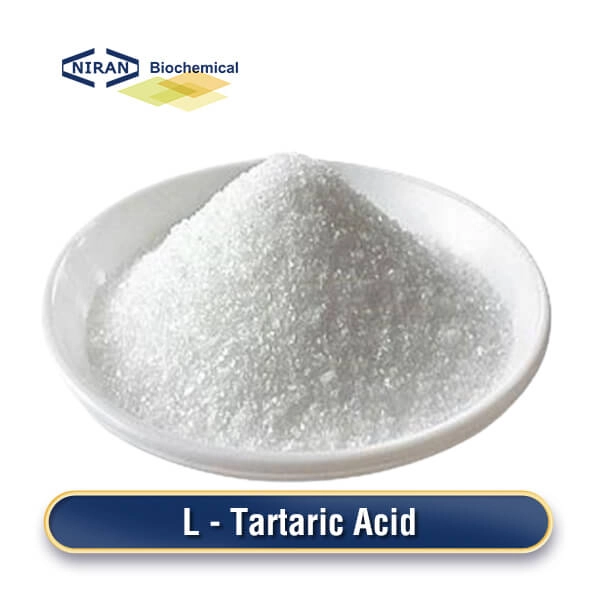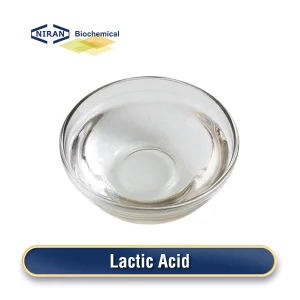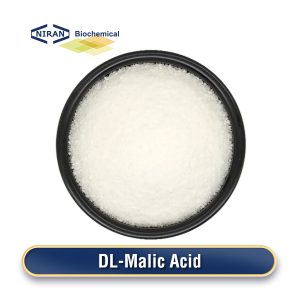Niran Biochemical
YOUR RELIABLE FOOD INGREDIENTS
Send Inquiry
Home » Products » Acidulants » L-Tartaric Acid
L-Tartaric Acid
- CAS: 87-69-4
- Chemical Formula: C4H6O6
- Certification: KOSHER, ISO, HALAL, FSSC22000, BRC, etc.
- Standard:
- MOQ: 1000KG
- Shelf Life: 2 Years
Inquire Product
Product Description
What is L-Tartaric acid?
L-Tartaric Acid appears as colorless translucent crystals or white fine to coarse crystalline powder, has a sour taste, is easily soluble in water and ethanol, but insoluble in ether and chloroform. L-Tartaric Acid can be used as a food additive and flavor enhancer in the food industry; in the biomedical field, it can be used to make drugs because of its various biological activities; in addition, in the cosmetics industry, L-tartaric acid can be used to make cosmetics because of its antioxidant and moisturizing properties.
The main sources of L-Tartaric Acid are wine and grape juice. In addition, some fruits, vegetables and fermented foods also contain L(+)-tartaric acid.
Related parameters:
| Items | Standards | Results |
| Description | Colorless crystals or white crystalline powder | Conforms |
| Content | 99.7~100.5 | 99.8 |
| Specific rotatory power [a]D[(°]· dm2kg-1 | +12.0~+13.0 | +12.6 |
| Loss on drying | ≤0.5 | 0.05 |
| Residue on ignition | ≤0.05 | 0.02 |
| Sulfate(SO4) | Passes test | Passes test |
| Oxalate | Passes test | Passes test |
| Lead mg/kg | ≤2 | <2 |
Recommended dosage:
| Food name | Maximum usage(g/kg) |
| Mints | 0.8-1.2 g/kg |
| Beverages | 0.6-1.0 g/kg |
| Coffee | 0.5-0.8 g/kg |
| Desserts | 0.5-1.0 g/kg |
| Salad dressings | 0.6-1.0 g/kg |
| Pickled foods | 0.6-1.0 g/kg |
| Canned foods | 0.6-1.0 g/kg |
| Seasonings | 0.8-1.5 g/kg |
| Jelly | 0.8-1.5 g/kg |
| Starch products | 0.5-1.0 g/kg |
| Ice cream | 0.6-1.0 g/kg |
L-Tartaric Acid has a wide range of uses
1. Food industry
Food additives: L-tartaric acid is often used in food processing, especially as an acidifier and stabilizer in beverages, juices, candies, etc.
Protein precipitation: In food processing, its protein precipitation properties can be used to help process and improve product quality.
2. Pharmaceutical industry:
Pharmaceutical intermediates: Used as intermediates in pharmaceutical processes to help synthesize and process drugs, especially pharmaceutical ingredients that require specific optical activity.
3. Wine industry:
Tartaric acid crystallization: In wine production, L-tartaric acid can crystallize to form tartar, which has an important impact on the stability and quality of wine.
Acidity regulation: Regulates the acidity and taste of wine, and plays a key role in the balance and persistence of its flavor.
4. Chemical synthesis:
Organic synthesis: Used as a catalyst or ligand in organic synthesis, it has an important catalytic effect on certain chemical reactions.
5. Construction industry:
Cement additives: As an additive for cement, it helps control the setting time of cement and improve its durability.
Building materials: used to adjust the hardening speed and strength of concrete and enhance the performance and stability of building materials.
User asked question
Q: What is the difference between L-tartaric acid and DL-tartaric acid?
A: DL-tartaric acid and L-tartaric acid are two compounds with similar chemical structures but different optical activities.
The mixture of D-tartaric acid and L-tartaric acid is DL-tartaric acid. The chemical structures of these two isomers are the same, but their stereostructures are mirror-symmetrical. The ratio of D-tartaric acid and L-tartaric acid is equal, so DL-tartaric acid has optical rotation, but its optical rotation is zero. In contrast, L-tartaric acid contains only one enantiomer, the left-handed isomer. This compound has optical rotation and its optical rotation is negative.
The metabolic activity of L-tartaric acid in the body is also different from that of D-tartaric acid. For example, L-tartaric acid can participate in energy metabolism, while D-tartaric acid is used to make drugs and food additives.



